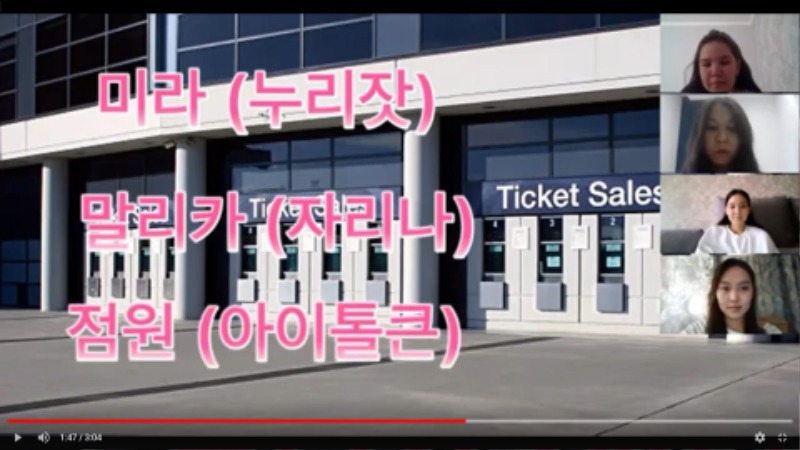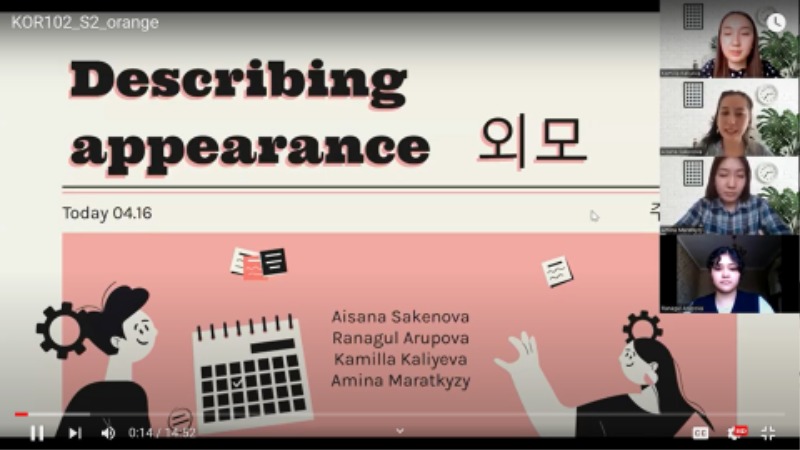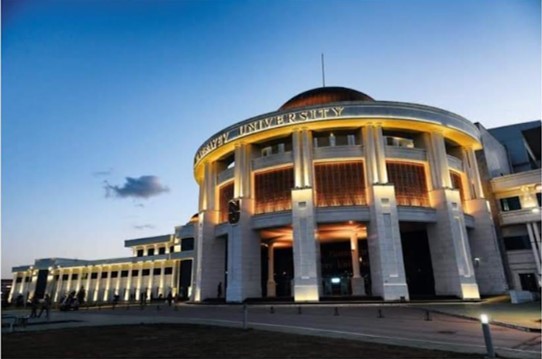[KF Mailbox]
Lucky to Teach Korean in Kazakhstan
Lee Heui-jin
Visiting Professor, Korean Language and Literature, Nazarbayev University (Kazakhstan)
I am lucky to be teaching Korean during these times. Korean culture is now so popular in Kazakhstan that I do not have to put extra effort into introducing cultural aspects in my language classes. I became a Korean teacher at a time when global interest in Korea has peaked and I even feel that I myself am growing popular, too. Lady luck shined brightly on me as I teach Korean at a time when Korea enjoys unprecedentedly explosive popularity abroad thanks to BTS, Parasite, and Squid Game.
The Kazakh language is grammatically similar to Korean and both tongues have many similar expressions. So even when I talk about difficult elements of Korean grammar, my students understand me with little difficulty thanks to the similar grammar and expressions of their native tongue. I am not fluent in Kazakh so I don’t know the similarities of the two languages, but my students say both are similar in expressions of emotion, action, and way of life, as well as sentence structure and grammar rules.
It wasn’t always easy for me to teach Korean to Kazakh students. My biggest hurdle was conducting all classes online due to the COVID-19 pandemic, a practice that marked my start at Nazarbayev University. Clueless about Zoom, I held classes using the app and communicating with students via the learning platform Moodle. This was the first time that I used both platforms, and a lot of time was needed to prepare for classes using them. Early on, I made mistakes during class as I was unfamiliar with both apps. The students would say “I can’t see you, Teacher,” or “Teacher, I can’t hear you.” At night when watching videos of my classes, I felt embarassed seeing myself at a loss while teaching.
As my online classes marred by mistakes and embarassment grew prolonged, I realized that conducting them like in-person classes was impossible. So I spent quite a bit of time to find better ways of teaching. While I was worried over my plan failing, I thought that my students would at least understand the need to try new ways of learning. Fortunately, they showed great interest in the new methods I presented. One worrisome factor was the method of student evaluation. To adopt a new way of assessing student performance was good, but I wondered if it might lead to unfairness. As it turned out, the students showed their prowess through assignments for evaluation and I could assess what they did without difficulty in observing basic rules. That said, I did need nearly two to three times more time to prepare for and evaluate my classes in the new ways.
So, this is how I adopted new methods to conduct my classes. First was the online “Cultural Participation.” Before the pandemic, my students could engage in cultural activities freely and actively like going to exhibitions, museums, and concerts, and I wanted to give them the chance to enjoy things despite being stuck in cyberspace. I encouraged them to take part in diverse forms of cultural participation to get good evaluation results. Such efforts included writing a review after watching a Korean movie or TV series or reading a Korean book; creating videos showing themselves singing Korean songs; writing essays after attending online seminars or workshops held by the university’s Korean Studies Center or interviewing Koreans. Participating in this activity, my students conveyed feelings and thoughts that they had longed to express through singing and writing, and I enjoyed watching, listening, and reading their assignments, sometimes shedding tears and laughing aloud.
Another method was “Dialogue Building,” a team-building assignment. Each class was divided into two groups and had to devise a brief story. Each group was further divided into three teams. When I suggested a situation, the first team of each group came up with a dialogue that suited the situation and the second followed the first’s story. While the second team completed the text, the first recorded it in the form of an online video. After the second team, the third team completed the text and used it to make and submit a video. In a nutshell, the students in teams produced a short, three-part video series. This might sound a bit difficult and complicated but the videos were too wonderful and fun for me to enjoy alone. I asked them to use only the words we studied during class and give “notes” through which they enumerated the words, expressions, and grammatical rules they employed. This new assignment provided a good opportunity for my students to utilize what they learned. Seeing the results of “Dialogue Building,” I could tell that my students’ command of Korean had markedly improved.

“Dialogue Building” is an assignment where students videos.
Another team mission was the “Final Teaching Presentation.” Each team taught one chapter of the textbook to the class, and submitted slides and other presentation materials, class videos, and a questionnaire. This assignment was based on the notion that students learn better when they do a bit of teaching. Each team produced 10 questions at the end of the chapter, and I included a couple of those questions in the final exam. The students conducted the class far more creatively than I could and trumped me again in giving explanations that were easy to understand. They also surprised me by posing better and more basic questions.

“Final Teaching Presentation” had student teams teach the class one chapter of the textbook.
For intermediate-level students, I assigned them to write letters to their “secret friends.” At the end of the semester, they had to make presentations on their friends and I evaluated their Korean speaking skills through the presentations. The students had limited information about their friends because they did not have a chance to meet one another in person. They tried to identify their friends based on the letters they exchanged, making the class more exciting. I asked my students to write the letters using words and expressions from the textbook, and I am proud that this exercise turned out to be a useful but fun teaching method that helped their language study.
From the next semester, all classes will go back offline, and I look forward to conducting classes in person. Yet, I do feel a little regret about going back to the classroom because teaching online was so exciting. But I will apply my attempts at improving online classes to run the offline classes, too. I see no problem in doing that and plan on offering far better opportunities to my students and expect progress in their Korean.
Above all, I consider myself an extremely lucky teacher because my students at Nazarbayev University are really smart, active, and marvelous. The school is rather new and named after former Kazakh President Nursultan Nazarbayev. It was only established in 2010, but it already attracts the most gifted students in the Central Asian country, so I feel immensely fortunate and honored to teach these students.

Nazarbayev University at sunset
Despite being the world’s ninth-largest country in area, Kazakhstan is rather unfamiliar to Koreans, and even I didn’t know where the country was before coming here. Many of my family members and friends remain confused about countries whose names end with “-stan” such as Kazakhstan, Pakistan, and Uzbekistan. So kudos to the Korea Foundation for sending professors to countries like Kazakhstan to teach students there. Korean-language textbooks usually include the sentence “Learning Korean is interesting,” but I want to add my own: “Teaching Korean is both interesting and fascinating.”
 한국국제교류재단
한국국제교류재단 newsletter
newsletter












